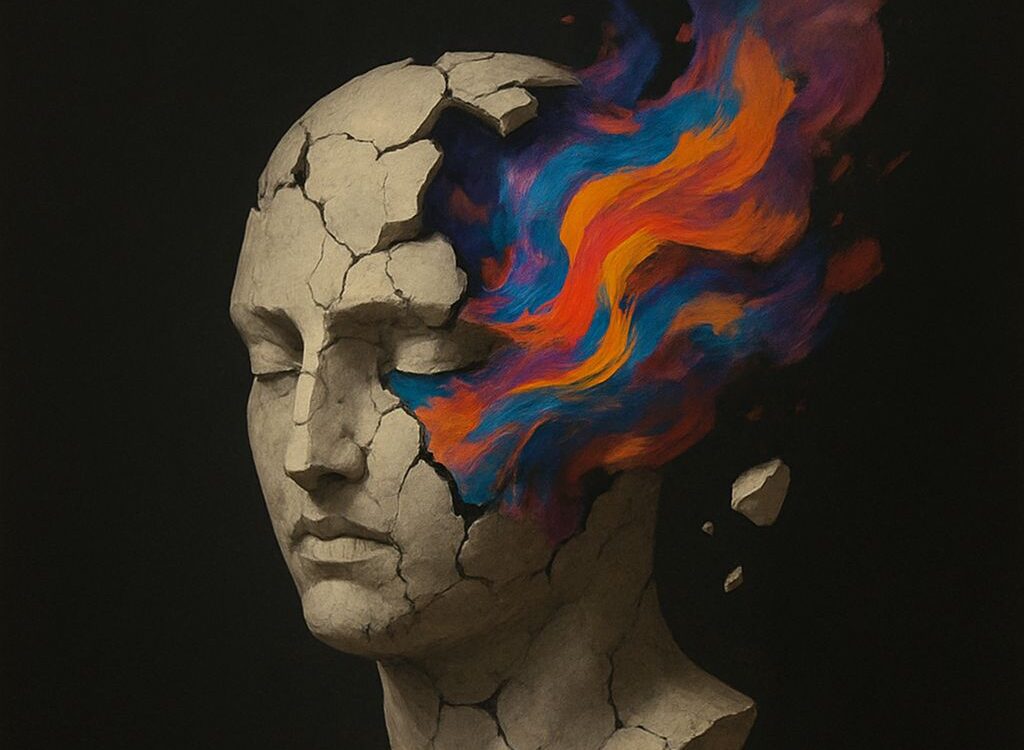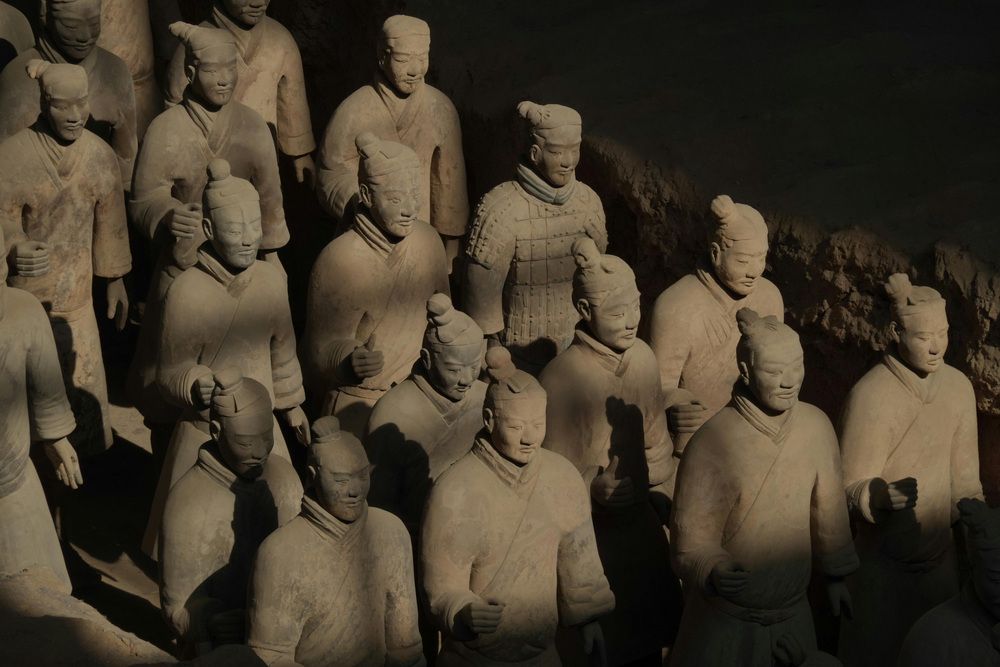
ENGLISH TEXT
BREAKING DOGMAS
The world is full of certainties we accept automatically. From childhood, we learn that certain emotions must be expressed in specific ways, that some ideas represent “absolute truth,” or that the teachings of our early years must remain unchallenged.
This blind adherence to unexamined ideas—this rigid loyalty to beliefs we refuse to question—gives rise to what we know as dogmatism.
Though we often associate dogma primarily with religion, its influence extends to other realms of thought: political ideologies, educational systems, scientific methods, and even our personal relationships.
We recognize dogma when an idea becomes so sacred that questioning it is seen as offensive or treasonous.
Dogmatism transforms opinions, theories, or beliefs into absolute truths that admit no debate. It’s like building walls around our ideas, shielding them from scrutiny or criticism. These mental fortresses provide security—but they also trap us inside.
The Skeptical Gaze
Even in ancient Greece, skeptics noticed humanity’s tendency to cling to unprovable certainties. The Pyrrhonists called these believers “dogmatists.”
When Sextus Empiricus, the foremost exponent of this school, examined the doctrines of his time, he documented an almost inevitable inclination to seek certainty—even when we lack full confidence in it.
In the 20th century, philosopher Willard Van Orman Quine challenged, in his essay Two Dogmas of Empiricism, the supposed distinction between analytic truths (certain by definition or logic) and synthetic truths (dependent on experience). He showed that this division blurs upon closer examination of how language and knowledge actually function.
This argument casts doubt on the untouchable foundations of science. Even in the scientific realm, dogmatism can emerge when certain basic assumptions are defended as unquestionable truths, sidelining the critical attitude and constant scrutiny that should characterize all knowledge-seeking.
Our knowledge is organized as a system of interconnected beliefs that barely graze experience at its outer edges. When reality contradicts part of this system, we have multiple options for adjustment—and often, we choose to preserve the most deeply rooted core beliefs, modifying only peripheral ones.
Scientific dogmatism, for example, tends to shield theoretical cores by creating increasingly complex auxiliary hypotheses to explain anomalies. Research programs can become “degenerative” when they spiral into this kind of dogmatic self-preservation.
The Social Dogma
In medieval religion, dogma functioned as both social glue and a defense of established power. Christian creeds dictated, with absolute authority, what believers must accept. Any attempt to rethink these truths could be deemed heresy—with tragic consequences in many cases.
This stance ensured communities remained united under a single, official version of faith. Dogma thus offered a “guarantee of the heart”—the comforting certainty of sharing immutable truths with others.
When everyone believes the same unshakable certainties, we experience a sense of belonging and shared purpose. This is why societies have historically developed systems to transmit and protect their core dogmas.
Religions—and by extension, other dogmatic systems—foster mechanical solidarity, a unity based on uniformity of thought. This communal bond creates stability but also resistance to change and hostility toward those who challenge established truths.
The Anthropology of Certainty
Humans need stable interpretations to make sense of life’s chaos. We crave patterns, explanations, and predictions to order our world.
Traditional societies develop elaborate classification systems separating the “pure” from the “impure,” the “ordered” from the “chaotic.” Often reinforced by taboos and rituals, these systems reduce anxiety in the face of ambiguity. From this perspective, dogmatism can be seen as a defense against the anguish of uncertainty.
Modern Dogmas
In today’s society, dogmas persist in forms we often fail to recognize.
One example is the meritocracy dogma—the belief that personal success depends solely on individual effort. When taken as gospel, this idea ignores social structures that privilege some and limit others. Those who don’t “succeed” are blamed for “not trying hard enough,” while the systemic advantages of the privileged remain invisible.
Other modern dogmas include:
-
The belief in infinite economic growth as the sole indicator of progress.
-
The idea that technology will solve all our problems.
-
The conviction that consumption is the primary path to personal fulfillment.
These narratives function as secular credos, rarely questioned in mainstream discourse.
Another pervasive dogma is happiness as an individual responsibility. This belief insists that everyone must “work on themselves” to achieve happiness, regardless of external circumstances. Promoted by the self-help industry and certain psychological approaches, it reframes social discontent as a personal attitude problem. The inability to be happy is treated as a moral failure—not a symptom of structural issues.
Epistemological Dogmatism
A school of thought called epistemological dogmatism argues that if something seems self-evident and there’s no reason to doubt it, we’re entitled to believe it. The intent is to justify basic beliefs without requiring proof—but this leads to the dogmatism paradox: How can we dismiss evidence that contradicts what we already hold as certain?
A possible solution lies in fallibilism, developed by Charles S. Peirce. From this view, we can maintain our beliefs as long as they remain uncontradicted—but we must be willing to revise them if new data emerges. Thus, knowledge rests on reasonable confidence paired with a constant readiness to correct errors.
We naturally lean toward confirmation bias: giving more weight to information that aligns with our existing beliefs. Cognitive psychology has studied this phenomenon, revealing how dogmatism is rooted in our very way of thinking.
Paralysis and Violence
Culturally, dogmatism leads to stagnation and impoverishment. Societies governed by rigid structures often suppress innovation, punish dissent, and cling to outdated practices. The history of science abounds with cases where valuable discoveries were delayed for decades due to blind adherence to dominant ideas.
Sociologist Zygmunt Bauman analyzed how modern dogmas of racial and social purity culminated in the Holocaust—and how projects framed as “rational” can become machines of extermination when backed by absolute certainties. The persecution of heretics during the Inquisition, ideological purges in totalitarian regimes, and the persistent denial of scientific evidence all illustrate the destructive power of closed thinking.
Information Bubbles and Polarization
Digital technologies have intensified dogmatic tendencies. Recommendation algorithms connect us mainly with content that confirms our preexisting views, creating echo chambers where divergent perspectives rarely penetrate.
Nuance, doubt, and compromise attract less attention than bold assertions and demonization of opponents. This dynamic fuels social fragmentation, splitting us into increasingly isolated and hostile ideological tribes.
Dogmatism as a Mechanism of Power
Michel Foucault examined how dogmatic discourses on sexuality, madness, or criminality have historically operated as tools of control over bodies and minds. So-called “unquestionable truths” about acceptable behavior shape reality. Claims like “this is human nature” or “this is how the economy works” present social constructs—often serving specific interests—as inevitable.
Dogmatism is never politically innocent. Absolute certainties tend to benefit certain groups, even when framed as universal truths. This is why many emancipatory struggles begin by dismantling these supposed “self-evident” justifications for the status quo.
“The problem with the world is that fools are so sure of themselves, while the wise are full of doubt.” —Bertrand Russell
THE NEW MASCULINITY
In recent decades, we have witnessed a transformation in how masculinity is understood and lived. What once seemed an unquestionable concept is now a terrain of scrutiny and reinvention. This metamorphosis aligns with the social, economic, and cultural shifts that have destabilized the foundations of traditional gender identities.
For centuries, a dominant notion associated masculinity with traits like physical strength, authority, economic provision, emotional control, and detachment from caregiving roles. From an early age, boys were socialized to assume the roles of providers, leaders, protectors, and even combatants. This vision was reinforced by custom, myths, religions, economic systems, and educational institutions.
Where does this cross-cultural consistency come from? Some evolutionary biologists point to hormonal and physical differences that predispose (though not determine) certain behavioral tendencies. Ancient selective pressures may have favored specific traits in environments of scarcity and danger, though others argue these patterns reflect similar mechanisms of domination reproduced across diverse contexts.
Despite this apparent universality, research has shown how masculinity varies considerably across historical and cultural settings. While common patterns exist—such as linking masculinity to competition or self-control—there are also communities where caregiving, cooperation, and emotional expression are integral to male identity. This proves that masculinity, like any gender identity, is malleable and contingent.
The traditional model functioned for millennia but began to fracture in the 20th century. Feminist movements challenged male privileges and dismantled the presumed “naturalness” of roles framed as biologically inevitable.
World Wars forced reorganizations of labor and domestic life. Industrialization and later the service economy diminished the social value of physical strength. Democracy eroded rigid hierarchies. The sexual revolution decoupled sexuality from reproduction. Women’s access to historically male spaces and struggles for expanded reproductive rights have compelled a reevaluation of what is expected of men today.
As traditional markers of success and fulfillment fade, many men experience a liminal state: no longer part of the old order but not yet situated in the new.
While women rightly celebrate their liberation from predetermined roles as an expansion of possibilities, many men experience the same liberation as a disorienting void. On one hand, they’re freed from imposed constraints; on the other, they lose a naturalized sense of purpose.
This loss of reference breeds a silent anxiety that, lacking socially acceptable outlets, may manifest in destructive behaviors or nostalgic retreat. It’s no coincidence that male suicide rates in industrialized societies are three to four times higher than women’s, while substance abuse and behavioral disorders show markedly male prevalence.
Men today are freer but less emotionally equipped to handle that freedom, exhausted by the constant labor of constructing an identity without clear or socially validated models.
Nostalgia for lost certainties fuels reactionary movements promising to restore a mythical order where “men were men.” These groups often thrive in precarious contexts, where the promise of gender superiority compensates for other deprivations. Many men feel they’ve lost a place that once offered them certainty, status, and recognition. In this vacuum, some turn to rhetoric pledging to restore an older order—where hierarchies were clear and rules went unquestioned.
This need for belonging also explains the rise of traditional and virtual male communities (from sports clubs to online forums), which serve as spaces where masculinity can be performed without constant scrutiny. The problem arises when these refuges become enclaves of resentment rather than sites of positive transformation.
The Asymmetry of Gender-Exclusive Spaces
The contradictions of our era are evident in gendered spaces. While initiatives like The Wing or Hera Hub are celebrated as necessary for female empowerment, analogous male spaces like The Bohemian Grove face harsh criticism as bastions of privilege.
Female-exclusive ventures are hailed as innovative, while any male counterpart would be swiftly labeled discriminatory. This double standard, though understandable as corrective logic, fuels resentment among men who don’t perceive themselves as privileged or oppressive—particularly working-class youth facing their own forms of economic and social marginalization.
This evaluative asymmetry isn’t arbitrary or ahistorical. Yet one might ask whether transformative justice requires such temporary disparities or if they risk reinforcing the very categories they aim to overcome. After decades of observation, some now question whether we’re creating a new set of restrictive stereotypes—only now applied to men.
Institutional programs like Canada’s Women’s Entrepreneurship Fund or female-targeted engineering scholarships are legitimate attempts to redress historical imbalances. Data showing women receive just 2.3% of global venture capital or hold only 28% of corporate leadership roles fully justify these interventions.
Yet these efforts coexist with less visible realities: men account for 93% of workplace fatalities, have significantly higher school dropout rates, and face 63% harsher sentences than women for the same crimes. The growing crisis in male education—where women now far outpace men in university graduation rates across most Western nations—rarely inspires compensatory programs.
A truly equitable approach would require acknowledging gender-specific vulnerabilities on both sides. Gender justice cannot be a zero-sum game where one group’s progress necessitates another’s decline.
The Body and Mental Health
A frequently overlooked aspect is men’s relationship with their bodies. Pressure to embody unattainable physical ideals has grown exponentially, evidenced by rising rates of dysmorphia and eating disorders among young men. The media’s inundation of “perfect” male bodies fosters a new alienation.
Trained to see their bodies as instruments of production or performance, many men become disconnected from their lived physical experience. This disaffection harms both their well-being and their capacity for meaningful intimacy.
Another neglected dimension is masculinity’s link to mental health. Emotional repression, isolation, reluctance to seek help, and fear of appearing weak stem from traditional affective conditioning. The consequences include chronic psychological distress, substance abuse, and self-inflicted violence. Without emotional literacy, any social transformation will remain incomplete.
Fatherhood as a Frontier
Parenthood now emerges as one of the most promising arenas for reinventing masculinity. Whereas fatherhood was historically limited to economic provision and normative authority, new family structures enable more participatory, affectionate, and caregiving forms of fathering.
This engaged fatherhood yields tangible benefits: children with higher self-esteem and better social skills, and men more satisfied with richer, more diverse social bonds. The experience of caregiving transforms not only children’s lives but the men themselves.
Yet workplace structures, cultural expectations, and family policies still hinder this shift. Asymmetrical parental leave (significantly shorter for fathers) or the persistent wage gap that makes it “economically rational” for mothers to reduce work hours exemplify how social systems reinforce traditional roles—even when both men and women seek to transcend them.
Beyond Binary Battles
This is not a war between men and women but a collective effort to redefine humanity beyond restrictive binaries. It’s about legitimizing diverse ways of being a man—including those that defy norms.
The Fascination with Collapse
The end is no longer announced by apocalyptic trumpets but revealed through scientific reports, rising global temperature graphs, deforestation maps, and matrices of interconnected crises. Collapse has transcended its status as a future threat to become the emotional climate of the present—a lens through which we interpret current events and sketch future possibilities.
The narrative of collapse seems to tell us that we will witness no great revolutionary transformations, nor a future that improves upon current conditions. Only the gradual crumbling of the systems that sustain industrial civilization—and with it, a strange attraction to this terminal image, as if contemplating it produced a liberating effect.
Why this fascination with the end? What are the implications of viewing collapse as the most plausible—or perhaps even desirable—horizon, as opposed to social transformation?
Utopian imagination has weakened. Collapsology emerges as a substitute for utopian thinking. Instead of projecting alternative societies or possible worlds, we devote ourselves to calculating variables of disintegration, points of no return, irreversible ecological thresholds.
If the 20th century was marked by grand emancipatory narratives, the 21st seems defined by tales of exhaustion, limits, and finitude.
Collapsology’s work proposes a pedagogy for developing emotional resilience in the face of what it deems inevitable. The contemporary subject does not prepare to radically transform the material conditions of existence but to survive their deterioration.
Collapsology has evolved as a school of thought. Early texts emphasized the scientific evidence of imminent collapse: physical limits to growth, energy crises, climate disruption, mass species extinction. Later theorizations incorporated psychological, communal, and existential dimensions.
Contemplating the great collapse provides a kind of existential relief. In a context defined by perpetual acceleration, fragmented experience, productive overexertion, and informational saturation, the image of total collapse offers a purification through chaos.
The imagined end acts as a simplifying force. It promises to reduce overwhelming reality to an elemental, primal situation. This fantasy of returning to basics exerts a powerful allure in hypercomplex societies where individuals constantly experience their powerlessness against abstract, uncontrollable systems.
The expectation of collapse incorporates a dimension of cosmic justice. The system that has exploited natural resources, vulnerable populations, and subjectivities for centuries seems to “deserve” its end. If organized political transformation seems unviable, collapse appears as an impartial judge delivering a verdict under the weight of accumulated systemic contradictions. This inverted hope becomes a peculiar refuge for critical thought when other paths of social change seem closed.
Yet, fascination with collapse can easily become a form of passivity disguised as analytical clarity. Contemplating apocalyptic scenarios may induce paralysis, much like the ideology of indefinite progress once did. The real danger lies in the premature collapse of collective will for transformation.
The certainty of disaster can function as a self-fulfilling prophecy precisely because it eliminates the uncertainty necessary for action. If we are absolutely certain everything will collapse, why strive to prevent it?
Unlike the sudden catastrophes imagined by ancient apocalyptic traditions, collapsological collapse is gradual, distributed, often imperceptible in immediate daily experience. What was once conceived as a spectacular event is now understood as an accumulative process—an “apocalypse without an apocalypse.”
Indicators of systemic exhaustion proliferate: water scarcity in expanding regions, rising mental health disorders, progressive degradation of agricultural land, institutional fatigue in established democracies, growing political polarization, social atomization… None of these alone constitutes a definitive rupture, but together they form a landscape of persistent deterioration. Modern collapse resembles less a bomb detonation than the silent advance of a chronic disease.
We inhabit a collapsing world without experiencing it as such at every moment. We cognitively adapt to deterioration, normalizing what would have been alarming decades ago. Collapse forms a constant atmosphere rather than a singular event. Like a “hyperobject,” it is too spatially and temporally distributed to be fully grasped through immediate experience.
Thus, consciousness inhabits a suspended time—a prolonged present that never fully crumbles nor offers clear possibilities for renewal. This temporal suspension corrodes modern grand narratives based on progress, without providing a new organization of historical time.
The Commercialization of Collapse
Collapsology has undergone cultural commodification. The end of the world has become a mass-media product. Apocalyptic documentaries, dystopian literature, post-collapse video games, YouTube survival channels, social media accounts meticulously tracking every new catastrophic symptom, TV series, films… The attention economy has incorporated civilizational fear as a profitable engine.
Digital algorithms, designed to maximize exposure time, systematically amplify the most unsettling scenarios, feeding a constant stream of catastrophic imagery. This mass circulation of apocalyptic representations fundamentally alters our relationship with the very idea of collapse.
By transforming collapse into a cultural commodity, we neutralize it as a mobilizing force. We turn it into spectacle, vicarious experience, entertainment. While we passionately debate whether a given extreme weather event constitutes definitive proof of climate collapse, we continue participating in the daily practices that accelerate it. The spectacularization of the end creates a distance that immunizes us against its practical urgency.
This generates a kind of cognitive schizophrenia: we recognize the gravity of converging crises, yet this knowledge rarely translates into meaningful changes in our ways of life. Media representations of collapse act as a pressure valve, relieving cognitive tension without altering the material conditions that produce it.
We live in the “age of hypocrisy”: we know too much to keep acting as we do, yet we persist while obsessively circulating knowledge about the unsustainability of our practices.
Beyond Fatalism
It seems neither viable to deny the objective gravity of converging crises nor acceptable to surrender to paralyzing fatalism. Collapsology gets many diagnostic aspects right: the world shaped by industrial modernity faces a multidimensional crisis. Yet the proper response cannot be limited to melancholic contemplation of anticipated ruins or morbid fascination with catastrophe.
Reflection on collapse must account for the multiplicity of temporalities at play: the planet’s geological time, the biological time of evolution, the accelerated time of financial markets, the electoral time of democracies, the intimate time of subjective experience… Each of these temporal registers experiences collapse differently.
What we call “collapse” is a complex of asymmetric processes. While some species vanish forever, others thrive in altered ecological niches. While certain social institutions disintegrate, unprecedented forms of community organization emerge. While some technological structures fail, others gain previously unimaginable centrality.
This temporal heterogeneity is crucial to overcoming a monolithic conception of collapse as a single, homogeneous event. What we experience is more accurately “patches of ruin”: zones where life continues under altered conditions, where destruction coexists with persistence, where irreversible loss does not preclude unforeseen possibilities.
Understanding this multiplicity helps avoid two opposite simplifications: reducing collapse to an instantaneous catastrophe or denying it entirely due to its gradual nature. We need “words to think what is happening to us”—words capable of capturing both the gravity of our situation and the possibilities still open within it.
Each era dreams the next as it sinks.
Collapsology serves an important function in dismantling dangerous illusions about the sustainability of our current civilizational model. But its greatest contribution may lie in helping us imagine what kind of life is worth living when the promises of industrial modernity have lost credibility—and what we might yet learn.
THE ETERNAL QUEST FOR IMMORTALITY
The boundaries of existence have been a constant throughout history. This longing is the driving force that has propelled civilizations, inspired masterpieces, and catalyzed scientific discoveries.
It was in ancient societies that the first attempts to conquer mortality took shape. In Egypt, mummification sought to preserve the body as the eternal dwelling of the ka and the ba. The pyramids stand as testaments to a culture that devoted immense resources to preparing for the afterlife, convinced that existence must continue beyond the physical threshold.
Qin Shi Huang, China’s unifier, sent expeditions to distant lands in search of mythical herbs and substances that might grant him eternal life—yet many of these emperors died ironically poisoned by the same mercury-laden compounds their alchemists claimed held the key to immortality. The famed Terracotta Army symbolizes an alternative form of perpetuity: if he could not live forever in flesh and blood, at least his memory and power would be immortalized in clay.
European, Arab, and Asian alchemists spent entire lives deciphering the secrets of matter, convinced that understanding nature would unlock the means to reverse aging and conquer death. Paracelsus, the 16th-century Swiss physician and alchemist, relentlessly pursued the alkahest, a universal solvent he believed could purify the human body of all disease and decay.
The world’s religions have offered various forms of transcendence: Christianity’s promise of eternal life after Judgment Day, Hinduism and Buddhism’s cycles of reincarnation, or ancestral rites that preserve memory in the collective consciousness. These spiritual constructs reveal humanity’s resistance to accepting the definitive end of individual awareness.
Literature has long grappled with this obsession—from Robert Louis Stevenson’s The Strange Case of Dr. Jekyll and Mr. Hyde to Mary Shelley’s The Mortal Immortal and Frankenstein; or, The Modern Prometheus, Jorge Luis Borges’ The Immortal, Milan Kundera’s Immortality, and countless others.
The 20th Century: A Paradigm Shift
The 20th century brought a new approach to immortality. Advances in medicine and biology doubled life expectancy in many societies. Diseases once considered death sentences became treatable or even curable. This biomedical revolution fueled scientific optimism, framing death as a technical problem to be solved.
Ray Kurzweil, Google’s futurist and engineering director, popularized the concept of the singularity—a hypothetical point where exponential technological progress would enable indefinite life extension. The transhumanist movement, of which Kurzweil is a leading voice, envisions the fusion of human and machine as the next evolutionary step, transcending biological limits—including death.
From supplement cocktails to self-administered experimental therapies and radical tech implants, modern seekers of immortality are turning their bodies into living laboratories.
Biotech and the Business of Immortality
Biotech companies have tapped into this ancient yearning, channeling it into aging research. Firms like Google-backed Calico invest millions in studying cellular aging, hoping to reverse or significantly slow it. Senolytics, a field focused on clearing aged cells from the body, promises not just longer lives but healthier ones.
CRISPR gene-editing technology has revolutionized interventions in aging and cellular degeneration. Scientists like Harvard’s David Sinclair explore how epigenetic reprogramming might reverse aging by restoring function to senescent cells. Regenerative medicine, using stem cells to rebuild damaged tissues, points toward a future where lab-grown organ transplants could indefinitely extend the human body’s lifespan.
Parallel research into plasmapheresis—transferring young blood plasma to older individuals—examines whether youthful components can revitalize aged tissues, blending science with a vampiric twist. Studies on the gut microbiome’s link to longevity reveal how bacterial composition directly impacts lifespan and health in old age.
Companies like Alcor Life Extension Foundation offer cryopreservation—freezing bodies or brains at ultra-low temperatures after legal death, betting that future tech will enable revival. This gamble hinges on defining death as the irreversible loss of brain information, not just biological cessation. Yet it raises existential questions: Would a revived individual be the same person or merely a physical copy with similar memories?
Vitrification (turning tissues into a glass-like state to avoid ice damage) has improved cryonics’ technical feasibility, but doubts remain about preserving the neural structures housing consciousness and identity.
Digital Immortality
Alongside physical efforts, digital immortality emerges as a parallel frontier. Our digital footprints outlive our physical selves. AI projects aim to create “digital twins” that simulate the personalities, knowledge, and thought patterns of the deceased, allowing the living to “converse” with algorithmic versions of lost loved ones.
This renewed pursuit of immortality coincides with secularization. As religious promises of eternal life wane for many, science and technology position themselves as new sources of transcendental hope. It’s no accident that Silicon Valley, the epicenter of tech innovation, is also a hub for life-extension movements.
Here, we see the rise of what might be called techno-religions. Transhumanism, championed by thinkers like Nick Bostrom and Max More, has crafted its own cosmology—where the technological singularity replaces religious apocalypse, and transcending the biological body substitutes spiritual salvation.
Ethical and Existential Dilemmas
Yet the dream of immortality poses profound ethical, social, and existential questions:
-
Psychology: Could a human psyche, evolutionarily adapted to finite cycles, endure an endless life?
-
Society: How would family, inheritance, or careers function if generations overlapped indefinitely? Would creativity stagnate without generational turnover?
-
Inequality: Life-extension tech would initially be accessible only to economic elites, creating a new stratification: the privileged “immortals” versus the mortal masses. This divide could spark unprecedented social tensions.
-
Governance: How would societies govern citizens with unequal lifespans? Would term limits prevent immortal elites from monopolizing power? Would new legal frameworks regulate immortal marriage, contracts, or intellectual property?
-
Ecology: Our systems assume generational turnover. Mass immortality would demand a radical rethink of resource use and habitable space. Elon Musk’s Mars colonization vision might reflect not just exploration but a need to accommodate extended lifespans.
-
Evolution: Generational renewal ensures genetic diversity and adaptation. An immortal species might lose the flexibility that secured our evolutionary success.
Is Immortality Even Desirable?
Philosophers have long questioned whether eternal life would be a blessing or a curse. Bernard Williams, in The Makropulos Case, argued that immortality would inevitably lead to unbearable tedium as novel experiences dwindled. Without evolving desires or unfinished projects, existence could devolve into existential indifference.
Martha Nussbaum suggests that a good life isn’t necessarily endless but one where we fully develop our human capacities. Finitude, she posits, lends preciousness to our experiences and relationships.
The immortality quest reveals humanity’s capacity to dream beyond apparent limits—but also our struggle to accept life’s fundamental conditions. Perhaps it’s less about escaping death than about making life meaningful. From pharaonic monuments to alchemical elixirs, timeless literature to cutting-edge biotech, the impulse remains the same: to leave a mark, to transcend, to declare that our existence matters enough to endure.



